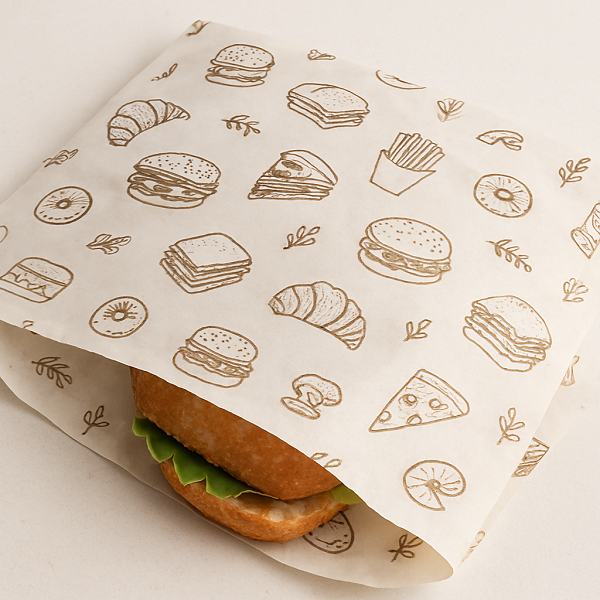Overview of Paper and Paper-based Food Packaging Materials
This overview provides a detailed examination of paper and paper‐based food packaging materials—from their basic composition and manufacturing processes to their applications, sustainability benefits, and emerging trends. Below is a structured analysis that covers the following key areas:
1. Introduction and Context
- Historical Perspective and Importance: Paper has been used as a packaging material for centuries, evolving alongside advances in papermaking technology. In the food industry, paper and paper-based materials are valued for their light weight, printability, and relative cost efficiency. Over time, innovations have led to a range of products—such as paperboard, corrugated fiberboard, and specialty films—that balance functionality with environmental considerations.
- Current Relevance: Given the increasing consumer and regulatory focus on reducing environmental impact, paper-based packaging has attracted significant interest as a renewable and potentially biodegradable alternative to plastics. This trend has spurred research into improving barrier properties and structural integrity without sacrificing sustainability.
2. Composition and Production Processes
Raw Materials
- Fibers: The primary constituents include cellulose fibers derived from wood pulp or recycled paper. The source and quality of fibers affect mechanical properties such as strength, flexibility, and durability.
- Additives: During manufacture, additives like fillers, sizing agents, and coatings may be included to enhance specific functionalities. These agents might improve moisture resistance, oil repellency, or print quality.
Manufacturing Process
- Papermaking: Involves pulping (either mechanical or chemical), cleaning, and refining fibers before sheet formation on a papermaking machine. The process is tuned depending on the end-use, with different grades required for plain printing papers versus food packaging.
- Conversion to Packaging: The produced paper can be further processed into various forms—folded into boxes, laminated with coatings, or combined with barrier layers to meet food safety standards. For example, coated paper is used to enhance grease resistance, while multi-layer structures integrate paper with other materials (e.g., aluminum foils, biopolymers) to provide necessary barrier properties.
3. Types of Paper-based Food Packaging Materials
Paperboard and Cartons
- Folding Cartons: Often used in packaging dry foods, confectioneries, and take-away meals. They are valued for their printability and ease of customization.
- Rigid Paperboard: Used for more structured products like cereal boxes or bakery packaging.
Corrugated Materials
- Corrugated Fiberboard: Primarily used for shipping and storage containers but also adapted for food packaging—especially where cushioning or structural support is required.
Coated and Laminated Papers
- Food Packaging Paper: Paper can be coated with barrier layers such as polyethylene, waxes, or biodegradable polymers to meet safety standards for direct food contact. The coatings help in preventing moisture, oil, or oxygen migration that can degrade food quality.
- Hybrid Systems: These systems often involve a combination of paper and alternative renewable or recyclable materials, aiming to strike a balance between barrier performance and recyclability.
4. Functional Properties and Design Considerations
Barrier Properties
- Moisture Resistance: Essential for maintaining food quality, as excessive moisture can lead to spoilage or structural compromise of the packaging.
- Grease and Oil Resistance: Important for packaging foods like fried items and fast foods. Coatings and surface treatments are typically applied to provide this resistance.
- Oxygen and Aroma Barriers: Specialized coatings can also prevent oxygen infiltration or loss of aroma compounds, which is crucial for products that are sensitive to oxidation or flavor degradation.
Mechanical Strength and Durability
The inherent tensile strength of cellulose fibers is exploited in paper packaging, and improvements in fiber bonding and layering techniques contribute to the overall robustness of the package.
- Thermal Stability: While paper-based materials have limitations in high-temperature applications, certain treatments and lamination methods allow for safe use in microwaveable or heated food contexts.
Printability and Aesthetics
Paper’s affinity for inks and coatings enables high-quality branding and product information printing, which is a significant advantage in consumer markets.
5. Sustainability and Environmental Impact
Renewability and Biodegradability
- Renewable Resource: Paper is typically made from sustainably managed forests or recycled fibers, making it a renewable resource.
- Biodegradable Options: Uncoated or lightly coated paper can biodegrade more readily than plastics; however, the addition of non-biodegradable coatings may complicate disposal and recycling.
Recycling and Circular Economy
- Recyclability: Many paper-based packaging products can be recycled through established systems. Challenges remain for multi-layered or heavily coated products, prompting ongoing research into recyclable barrier coatings.
- Environmental Footprint: Innovations in production (such as using bio-based additives or improving energy efficiency) are reducing the overall carbon footprint associated with paper packaging.
Policy and Market Trends
Increasing regulatory pressure to reduce single-use plastics and consumer demand for sustainable packaging are major drivers behind the growth and development of paper-based packaging solutions.
6. Emerging Innovations and Future Trends
Nanotechnology and Smart Coatings
- Enhanced Barrier Properties: Research into nanomaterials and bio-nanocomposites is opening new avenues for improving water, oil, and gas barrier properties without compromising recyclability.
- Active Packaging: Incorporating natural antimicrobials or antioxidants into coatings can extend the shelf life of foods and provide real-time quality monitoring.
Digital Printing and Customization
Advances in digital printing are enabling more efficient and aesthetically appealing packaging solutions that can be rapidly customized for different markets or even individual products.
Integrated Sustainability Approaches
- Life Cycle Analysis (LCA): Companies and researchers increasingly use LCA to evaluate the environmental impact of packaging choices, ensuring that innovations align with sustainability targets.
- Hybrid Materials: Combining paper with other biodegradable or recycled materials to optimize both performance and sustainability is an area of active development.
Paper and paper-based food packaging materials offer a versatile and increasingly sustainable alternative to conventional plastics. Their performance, driven by advances in coatings, manufacturing technologies, and material science, meets many of the functional demands of food packaging. However, challenges remain—especially in enhancing barrier properties and recyclability for complex packaging formats. As sustainability pressures intensify and consumer demand for eco-friendly products grows, research and innovation are likely to continue driving advances in this field.








































